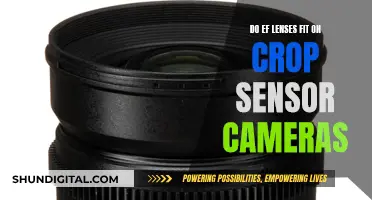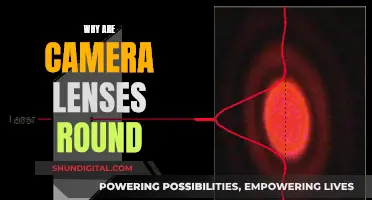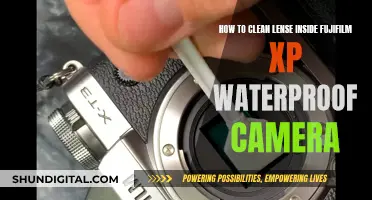
Camera lens filters are an essential tool for photographers, offering protection and the ability to create stunning effects. While post-processing software has made filters less crucial, certain effects are challenging or impossible to replicate digitally. Filters modify the behaviour, quality, and intensity of light before it hits the camera sensor, resulting in various interesting and practical outcomes. This article will discuss the must-have filters for your camera lenses to enhance your photography.
| Characteristics | Values |
|---|---|
| Type | UV/Haze, Skylight, Polarising, Neutral Density (ND), Graduated ND, Light Pollution, Infrared, Black and White, Close-up, Soft Focus, Protection |
| Effect | Mitigate UV light, cut through atmospheric haze, saturate colours, remove glare, blur moving objects, reduce light, improve night shots, create black and white effect, enable close-up photography, reduce contrast, protect lens |
| Application | Landscape, astrophotography, portrait, event, wildlife, infrared, black and white, close-up, video |
| Format | Circular, square, magnetic, clip-on, screw-in, variable, fixed |
| Considerations | Quality of glass, coatings, retaining ring, vignetting, colour cast, size, compatibility, price |
What You'll Learn

Polarising filters
There are two types of polarising filters: linear and circular. Linear polarising filters have a single polarising layer and are known to cause issues with metering and autofocus on SLR and DSLR cameras. Circular polarising filters, on the other hand, have an additional quarter-wave layer that repolarises the light, making them safe to use on any digital camera.
When purchasing a polarising filter, it is important to consider the quality of the glass, coatings, construction, and retaining rings. Pricier filters tend to use optically purer and thinner glass that interferes less with the front element of the lens. It is also recommended to prioritise brass construction over aluminium to prevent dents and jams.
Overall, polarising filters are a valuable tool for photographers, enabling them to capture vivid images with enhanced contrast and colour saturation.
Black Friday Camera Lens Deals: What to Expect
You may want to see also

Neutral density (ND) filters
ND filters come in two varieties: square and circular. Square filters slot into a holder attached to the lens, making them easy to remove and replace, while circular filters screw directly onto the lens and require less equipment. However, circular filters may not be compatible with ultra-wide lenses that have bulbous front elements. Ultimately, the choice between square and circular ND filters comes down to personal preference and the specific setup being used.
ND filters also vary in strength, with stronger filters reducing more light. They are typically referred to using terms like "ND 1.8" or "ND64", but it is simpler to refer to the stop count, which all ND filters specify. For example, an ND64 filter will reduce exposure by six stops.
When choosing an ND filter, it is important to consider the thread size to ensure it will screw into the front of the lens correctly. Additionally, some filters, particularly cheaper ones, may affect the colour of an image, resulting in a warmer or cooler cast. While this can be corrected in post-processing, it is important to be aware of this potential issue before selecting a filter.
- Cokin Nuances Extreme ND Z-Pro: Available in 6- and 10-stop densities, these filters offer flawless colour accuracy and premium manufacturing quality.
- H&Y K-Series HD MRC 100mm ND: These square filters feature magnetic frames, allowing for easy attachment without the need for a holder.
- Lee Filters ProGlass IRND: This premium option delivers uncompromising optical quality, with a range of density options from 2-stop to 15-stop.
- Kase Wolverine: Named for their toughness, these filters are scratch-resistant, water-repellent, and anti-reflective. They come in a range of sizes and densities, accommodating a broad field of view for wide-angle lenses.
- Lee Elements Big Stopper: The screw-in version of the beloved Lee Big Stopper, this 10-stop ND filter is highly effective at blocking light and comes in four filter thread sizes: 67mm, 72mm, 77mm, and 82mm.
- Hoya Pro ND: This budget-friendly option offers excellent image quality, with no negative impact on sharpness and only a slight deviation in colour accuracy. It comes in a range of sizes and densities, making it a versatile choice.
- Urth ND1000 Filter Plus+: With 18 different sizes and five density options, this filter stands out for its versatility. It uses high-quality Schott glass and coatings to aid light transmission and ease of cleaning.
Squaretrade Coverage for Camera Lenses: What You Need to Know
You may want to see also

Ultraviolet (UV) filters
UV filters are a popular choice for photographers who want to protect their lenses from scratches, dust, and other environmental hazards. They are also useful when shooting outdoors in hazy conditions, as they can help to reduce the amount of UV light that reaches the sensor, resulting in sharper images with better contrast.
When choosing a UV filter, consider the quality of the glass and coatings used. Higher-quality filters will have thinner glass that interferes less with the front element of your lens. Look for filters with multiple coatings to protect against lens flare, ghosting, and reflections. Some filters also come with a protective case, which can be useful for storing and transporting your filter.
- Hoya HD Nano Mk II UV: This filter blocks UV light effectively and uses shatter-resistant glass for added protection. It has a knurled front edge for easy grip and comes in a range of thread sizes.
- Tiffen UV Protector: A budget-friendly option that comes with a 10-year warranty. It reduces the bluish cast of daylight and can be paired with other filters. It is available in a wide range of thread sizes.
- K&F Concept Nano-X UV: A premium option that uses Japanese optical glass and an aluminum frame. It features a 28-layer multicoating for scratch resistance and is available in a variety of sizes.
- Urth UV Filter Plus+: A premium, environmentally-conscious option that can cut up to 99.6% of UV light. It uses Schott B270 glass with 30 layers of nano-coating for easy cleaning and protection. It comes in a range of sizes from 37mm to 127mm.
Amazon Prime Day: Camera Lenses Included in the Sale?
You may want to see also

Protective filters
UV filters, also known as haze filters, are a type of protective filter that can be left on the lens at all times. They are used to mitigate the effects of atmospheric haze, moisture, and other airborne pollutants that cause image degradation. They are especially handy when photographing in areas with intense ambient ultraviolet light, such as near large bodies of water, at higher altitudes, or in the snow.
When choosing a UV filter, it is important to consider the quality of the glass. Pricier filters tend to use optically purer and thinner glass that interferes less with the front element of your lens. The coatings on the glass are also important, as higher-quality filters will have better anti-reflective and colour coatings. In addition, the retaining ring should be considered, with brass construction being preferable to aluminium, which tends to dent and jam.
While UV filters are the most common type of protective filter, skylight filters are another option. These filters have a magenta tint and are available in two strengths: 1A and 1B. They are useful when photographing skin tones or using colour slide film, as the magenta colouring can counterbalance the blue bias found in certain film stocks. Like UV filters, skylight filters can also cut through atmospheric haze. However, they do not impact camera exposure.
When choosing a protective filter, it is important to consider the quality of the filter in relation to the quality of your lens. If you are using a high-performance or telephoto lens, it is worth investing in a higher-quality filter to avoid compromising the lens's overall performance. On the other hand, if you are using a basic kit lens or trying out filters for the first time, an inexpensive filter may be a good option.
The Art of Handling Camera Lenses: A Beginner's Guide
You may want to see also

Graduated filters
When choosing a graduated filter, it's important to consider the shape, neutrality, density, material, and versatility. Rectangular ND filters are typically more versatile and easier to use than circular screw-in filters, which can be restrictive. It's also crucial to select a filter that is neutral and does not introduce any noticeable colour casts or fuzziness to your images. The density of the filter will depend on your specific needs, but it's important to strike a balance to avoid overexposed skies or overly dark backgrounds. Optical-grade plastic filters are lighter and more shatter-resistant than glass filters, but they are more prone to scratches, so careful handling is necessary. Finally, consider investing in a filter system that allows for the addition of other filters, such as polarizers or colour grads, to add creativity to your images.
Camera Kit Lenses: Worth the Money or Worthless?
You may want to see also
Frequently asked questions
The most basic filters are ultra-violet reducing filters, skylight filters, and protection filters.
UV filters are used to mitigate the effects of atmospheric haze, moisture, and other airborne pollutants that cause image degradation. They are especially handy when photographing areas with intense ambient ultraviolet light, such as near large bodies of water, at higher altitudes, or in the snow.
Polarising filters are most handy when photographing outdoors, where they saturate colours and make clouds pop against the sky. They can also eliminate glares and reflections bouncing off water, glass, and other polished surfaces.
ND filters are grey-toned filters designed to absorb calibrated degrees of light as it passes through the lens. They are used to allow the photographer to shoot at wider f-stops under bright light and to blur moving objects.
Graduated ND filters are used to even out scenes containing extreme exposure variations on opposite sides of the frame, such as when the top of a mountain is bathed in sunlight, while the valley below lies in shade. They can also be used to darken the sky or foreground for stylistic reasons.







